Most “90-Day Plans” look great on paper… Until you actually try to follow them for yourself. Late summer into early fall is prime “new job” season. Companies are back from summer slowdowns, budgets open up, and a flood of fresh new-hires and interns hit the ground running. The problem? Most of them start with a glowing sense of possibility… and a generic 90-day plan they pulled off the internet from 2004.
The trouble with those plans isn’t that they’re technically wrong, they’re just not built for how real workplaces operate, especially with the rise of AI. They tell you to “make an impact” by week three, without explaining how to do it; all when you don’t even know where the good coffee is yet.
This Diversity Employment version’s a little different. It’s practical. Paced. And it’s written so you can actually stick to it without burning out or accidentally stepping on toes. You’ll focus on three things that matter most in your first few months: learning the landscape, getting visibility in a good way, and building relationships that last longer than your onboarding.
By the end of your 90 day plan, you won’t just be “settled in.” You’ll be someone people remember, and want to work with again.
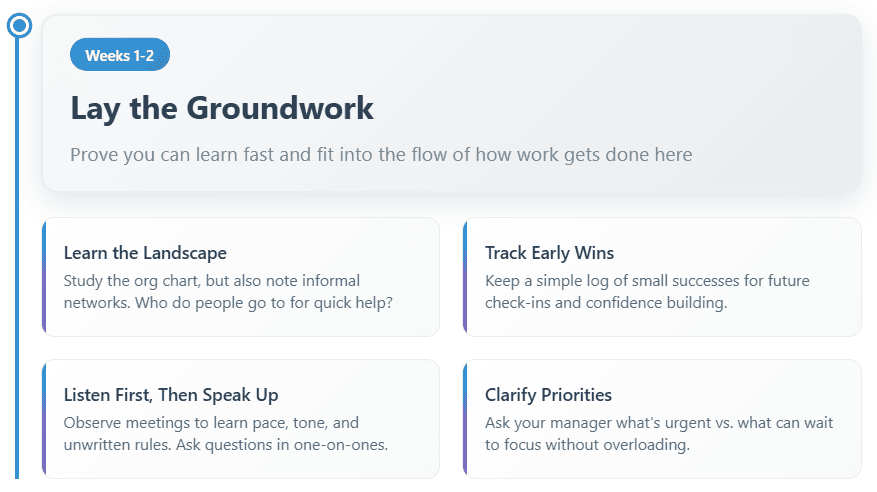
Weeks 1-2: Lay the Groundwork
Your first two weeks of this 90 day plan aren’t about proving you can already do everything, they’re focused on proving you can learn fast and fit into the flow of how work gets done. That starts with understanding the people, the process, and the priorities.
Learn the Landscape
Learn the organizational chart, but try to peek past just the titles. Pay attention to who actually makes the decisions, who people go to for quick help & answers, and which teams work closely together. That informal network matter as much as the formal structure.
Track. Your. Wins.
Keep a running log of all your small wins (no matter how small, they can add up and sound really good later). Solved a problem without needing a second reminder? Got a compliment on a report? Finished something ahead of schedule? Capture all of it. Those, seemingly small, details will give you positive material for check-ins later.
Listen First, Then Speak Up
Listen more than you talk in meetings. There will be a lot of new stuff to pick up on… jargon, inside jokes, unwritten rules (the things that no onboarding packet will ever fully explain). If something is fuzzy or unclear, quickly jot down a note and ask for clarity on it, in a one-on-one setting later.
Clarify Priorities
The possibly most important thing is, as soon as you can, clarify your job’s immediate priorities with your manager. Knowing what’s urgent and what can wait will keep you proactive and from overcommitting yourself in your first month.
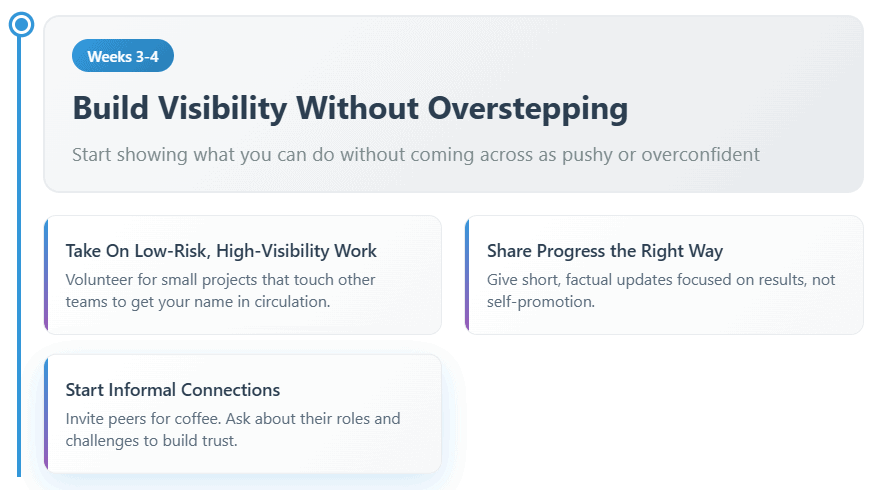
Weeks 3-4: Build Visibility Without Overstepping
Once you’ve learned the basics, it’s time to start showing your coworkers what you can do. The only thing is… You have to try to do it without coming across as cocky, pushy, or overconfident.
Take On Low-Risk, High-Visibility Stretch Work
Volunteer for small projects that touch other teams or departments. It could be helping with a report, updating a shared resource, or assisting on a presentation. These jobs get your name in circulation without putting you in over your head.
Share Your Progress the Right Way
Give a short daily update in your team’s chats or a quick email to your manager. Keep them factual and focused on the results achieved or that you’re working toward, not self-promotion. People remember consistency more than one single BIG win.
Start Networking!
Grab a coffee with a coworker. Or, if you’re remote, invite them on a short video call. Nothing formal. You’ll just want to ask what their job’s really like, what’s been a challenge lately, and whether your work has anything in common with theirs. You’ll probably get info you’d never hear in a group meeting. And, without making a big deal of it, you’re laying the groundwork for trust.
By week four of this 90 day plan, you want people to recognize your name and have a general idea of what you can handle. Once that’s in place, it’s a lot easier for new opportunities to find you.
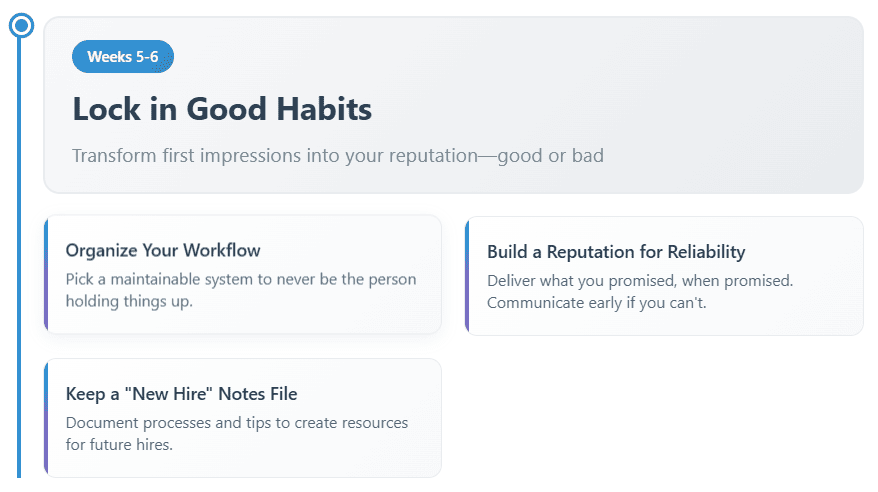
Weeks 5-6: Lock in Good Habits
The honeymoon period is over. This is where your first impressions can become your reputation, good or bad.
Organize Your Processes
Stick with a system you can fully maintain, whether you’re using a project management tool, a calendar with reminders, or a simple notebook with checkboxes (that’s me). The goal is to never be the person holding things up because you lost track of where a task should have been.
Build a Reputation for Reliability
Deliver what you promised. When you promised it. If you can’t, communicate everything early. Reliability isn’t only about how much you can output, it’s about being predictable… in the best kind of way.
Keep a “New Hire” Notes File
Write down processes, tips, and fixes you’ve learned since starting. Later, this can be turned into a resource for future hires, which lights you as someone who can improve the team beyond your own work.
By the end of week six, you should be known as: organized, dependable, and already making the team’s life easier.
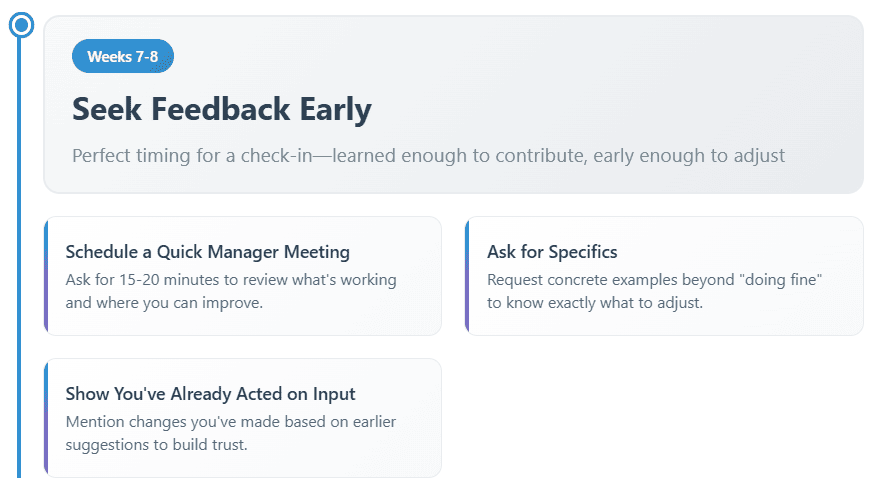
Weeks 7-8: Get Early Feedback
Two months in is that sweet spot for a check-in. By now you’ve learned enough to really contribute, but it’s early enough to make proactive changes without undoing months of habits.
Schedule a Quick Manager Meeting
Ask for 15-20 minutes to talk about your review and how things are going. Keep the agenda short: What’s working. Where you can improve. And, how your work aligns with the company’s goals and priorities.
Ask for Specifics
“You’re doing fine” simply isn’t feedback. You need specific and concrete examples so you know exactly what to keep doing, and exactly what to adjust.
Show You’ve Already Acted on Input
If you’ve made changes based on earlier suggestions, mention them and how changed. It shows you listen and follow through, which builds trust faster than promising to change.
A feedback loop = fewer surprises later. It also positions you as someone committed to continuous growth, which is one of the most in demand skills these days.
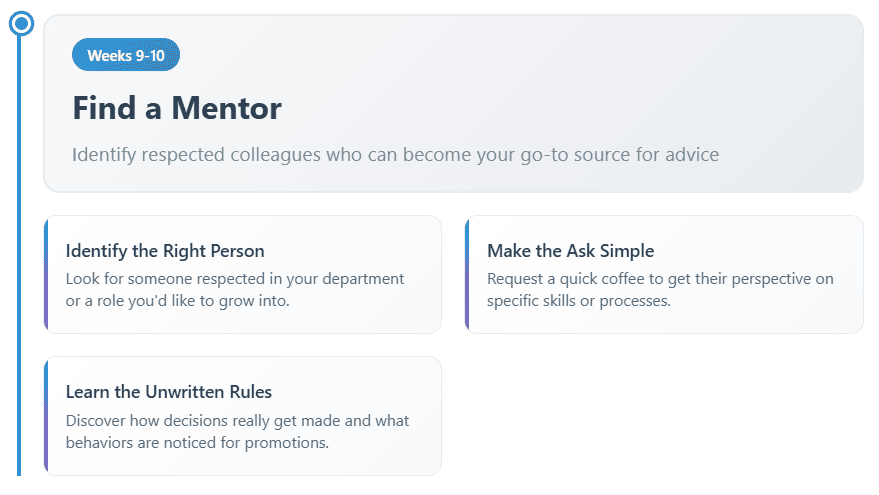
Weeks 9-10: Find a Mentor
By this stage, you know the landscape well enough to spot the people whose work and reputation stand out. One of them could become your go-to source for advice.
Identify the Right Person
Look for someone respected in your department or in a role you’d like to grow into. They don’t have to be your manager, sometimes it’s better if they’re not.
Make the Ask Simple
You shouldn’t be trying to set up a whole formal mentorship program here. Keep it simple. Something like, “I’d love to hear how you handle [specific skill or process], would you be open to a quick coffee or short call?” is low pressure and an easy yes, for most people.
Learn the Unwritten Rules
Mentors can give you the kind of perspective no handbook is going to have. Things like how decisions are actually made, which projects are the most important, and what really gets noticed when it comes to opportunity and promotions.
Having that kind of guide can cut months off your learning curve and sometimes put you in rooms you wouldn’t have had a foot in on your own.

Weeks 11, 12 and Beyond: Make a Measurable Contribution
You’ve built trust, learned the systems, and expanded your network. Now it’s time to deliver something people can point to as your work.
Take Ownership of a Small Project
Pick something that matters enough to management to get noticed, but that’s not so big that it’s too difficult to finish well. Maybe it’s tightening up a process, building a new helpful resource, or taking the lead on a short project that’s just been floating around.
Present Your Results
Once you wrap up a project, don’t just move on… Let people know! Walk through what you did, the difference it made (or is going to make), and what’s coming next. You could do this in a team meeting, in a quick chat with your manager, or even dropped into the daily notes your team sees.
Leave Something Behind
Document your daily process or create a guide other new hires can use. This turns your work into a lasting asset, not a one-off contribution.
By the time you hit week twelve of your 90 day plan, you want your managers to have real and specific examples of the value you’ve added, plus a reason to keep sending more responsibility your way.

Final Review & Future Positioning
Hitting the end of your 90-day plan closes out onboarding; it’s also a good chance to see where your job is headed next.
Schedule a 90-Day Review
Ask your manager to sit down for a quick review. It doesn’t need to be a big ordeal. Five or ten minutes is plenty. Use it to touch base on what’s most important right now and make sure you’re putting your energy where it matters most.
Summarize Your Wins
Bring a short Google Doc list of what you’ve accomplished since starting. Include specific results, positive feedback, and any process improvements you’ve contributed to.
Ask About Next Steps
Use this time to talk about where you could stretch into more responsibility. You might ask, “What skills should I be working on next?” or, “Where could I make a bigger impact in the next quarter?” Questions like that keep the conversation going and prove you’re looking ahead.
The idea is to walk out of the meeting being seen as more than a good hiring decision. You want to be seen as a team member already who’s on their radar for bigger challenges.
FAQs
What if I’m remote, does this still work?
Yes. You’ll just adapt the visibility tactics. Instead of hallway chats, schedule short virtual coffee meetings. Share updates in team channels and show up consistently in meetings with both your camera and contributions.
How do I get noticed without looking pushy?
Focus on being visible through reliability and useful input, not self-promotion. Volunteer for cross-team work, share credit generously, and make your contributions easy for others to see.
What if my manager is too busy for feedback?
Ask for a quick, standing check-in, ten minutes is often enough. Or send a short monthly email summarizing your progress and asking one targeted question. Busy managers appreciate concise updates.
I missed the beginning of the 90-day plan… Am I too late?
Not at all. The same steps work at any stage, though you may need to condense them. Prioritize relationship-building and quick wins first, then work in the rest as you go.
What if I make a mistake early on?
Own up to it quickly, fix what you can, and share what you’ll do differently next time. Most managers care less about the mistake itself and more about how you respond to it. A fast recovery can actually build trust.
Should I focus more on learning or performing in the first 90 days?
Both! But lean toward learning in the first month, then gradually shift toward delivering results. Understanding the context and culture before taking big swings usually leads to better, more sustainable performance.




